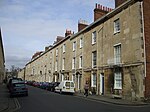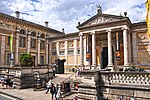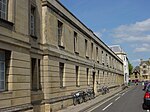Bodleian Art, Archaeology and Ancient World Library
2001 establishments in EnglandDeposit librariesLibraries of the University of OxfordLibrary buildings completed in 2001New Classical architecture ... and 1 more
Sackler family

The Bodleian Art, Archaeology and Ancient World Library (‘Bodleian Art Library’ in its shortened form, formerly the Sackler Library) holds a large portion of the classical, art historical, and archaeological works belonging to the University of Oxford, England.
Excerpt from the Wikipedia article Bodleian Art, Archaeology and Ancient World Library (License: CC BY-SA 3.0, Authors, Images).Bodleian Art, Archaeology and Ancient World Library
St John Street, Oxford City Centre
Geographical coordinates (GPS) Address Website External links Nearby Places Show on map
Geographical coordinates (GPS)
| Latitude | Longitude |
|---|---|
| N 51.755555555556 ° | E -1.2611111111111 ° |
Address
Bodleian Art, Archaeology and Ancient World Library & Griffith Institute
St John Street 1
OX1 2LG Oxford, City Centre
England, United Kingdom
Open on Google Maps









